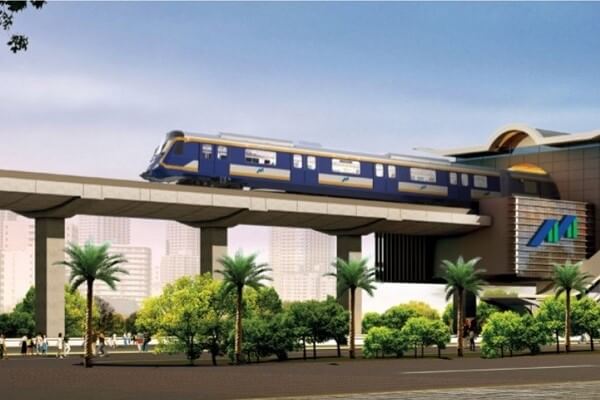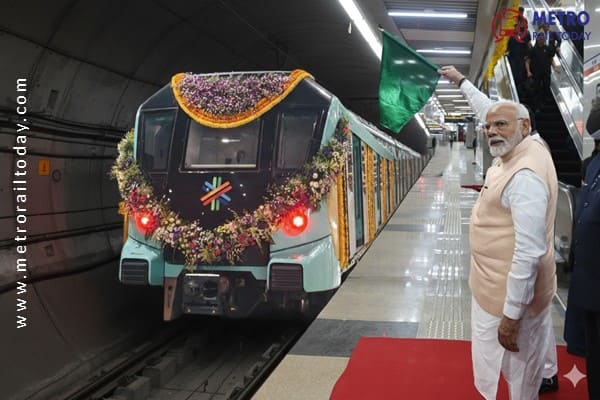 Prime Minister Narendra Modi inaugurates Final Phase of Mumbai Metro Line 3 (Aqua Line)
Prime Minister Narendra Modi inaugurates Final Phase of Mumbai Metro Line 3 (Aqua Line)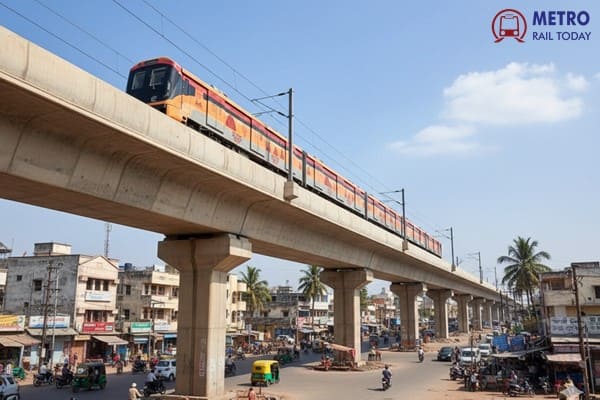 White Elephants on Rails: How Politically-Driven Metro Projects Are Draining Public Funds?
White Elephants on Rails: How Politically-Driven Metro Projects Are Draining Public Funds?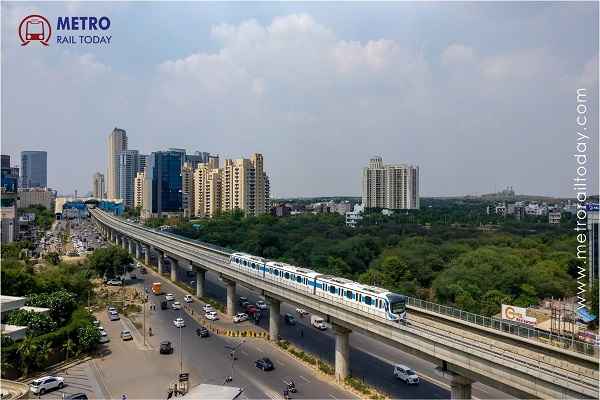 Gurugram Metro Construction Begins with First Piling Work Near Sector 31
Gurugram Metro Construction Begins with First Piling Work Near Sector 31 NCRTC and Gati Shakti Vishwavidyalaya sign MoU to boost Railway Education and Innovation
NCRTC and Gati Shakti Vishwavidyalaya sign MoU to boost Railway Education and Innovation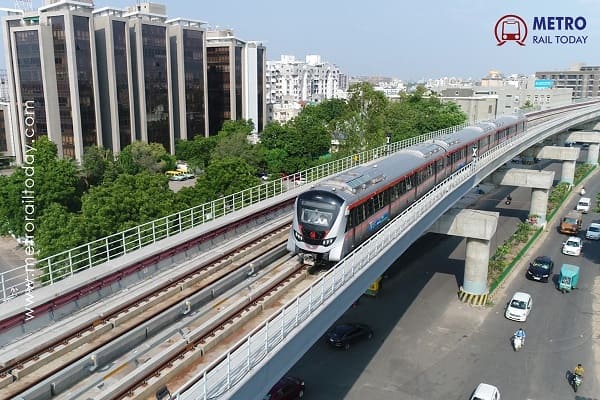 DB Engineering & Consulting partners with GMRC to shape Smart, Sustainable Surat Metro
DB Engineering & Consulting partners with GMRC to shape Smart, Sustainable Surat Metro Patna Metro Inaugurated: First Phase of 3.6-km Stretch Open to Public from October 7
Patna Metro Inaugurated: First Phase of 3.6-km Stretch Open to Public from October 7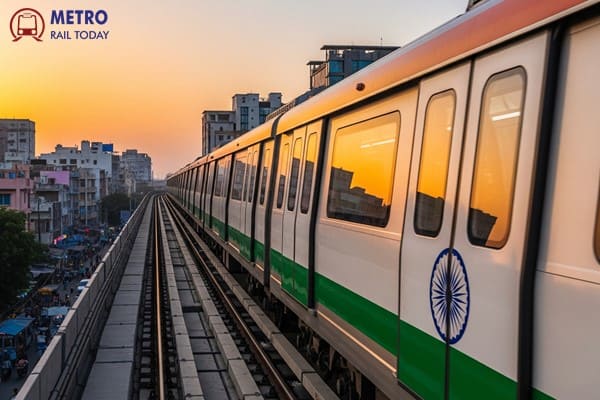 Saleem Ahmad appointed as new CMD of Rail Vikas Nigam Limited (RVNL)
Saleem Ahmad appointed as new CMD of Rail Vikas Nigam Limited (RVNL)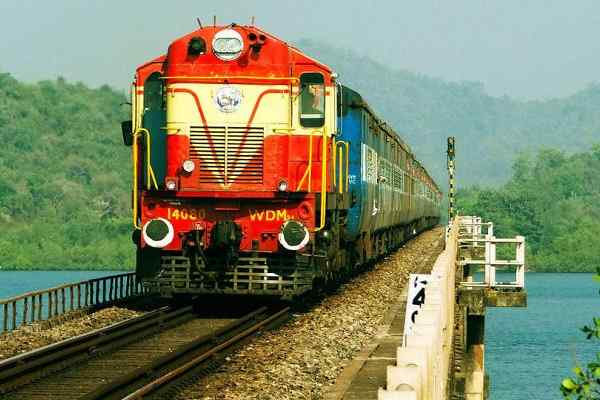 HCC and Konkan Railway sign MoU to deliver Large-Scale Rail and Metro Projects
HCC and Konkan Railway sign MoU to deliver Large-Scale Rail and Metro Projects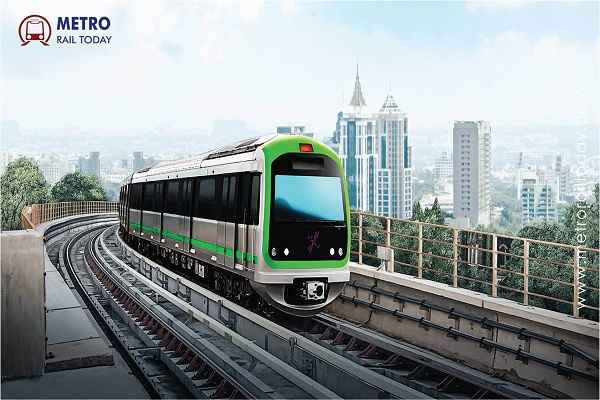 Karnataka approves Feasibility Study for ₹20,649 crore Bengaluru–Tumakuru Metro Extension
Karnataka approves Feasibility Study for ₹20,649 crore Bengaluru–Tumakuru Metro Extension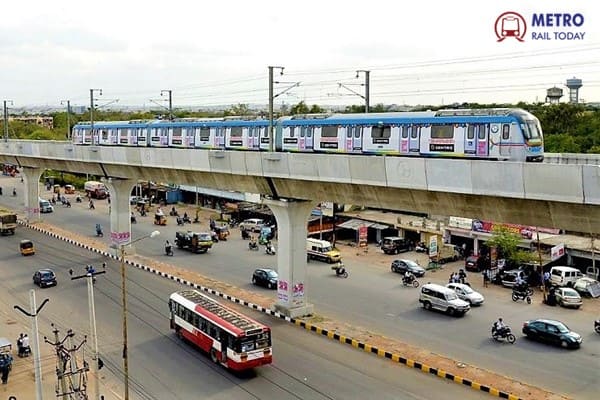 Learning from Exits: Re-evaluating the Public-Private Partnership Model in India's Metro Projects
Learning from Exits: Re-evaluating the Public-Private Partnership Model in India's Metro Projects
Assistive technologies can enhance mobility for elderly passengers in public transport

Older individuals contribute significantly to the wealth of any society. Ageing is a natural process that brings both opportunities and challenges. Globally, the population is ageing rapidly. Between 2015 and 2050, the proportion of the world’s population over 60 years will nearly double, from 12% to 22%.Mental health and well-being are as important in older age as at any other time of life. Mental and neurological disorders among older adults account for 6.6% of the total disability (DALYs) for this age group.
Approximately 15% of adults aged 60 and over suffer from a mental disorder. Based on the Census 2011 data, India is home to 104 million individuals aged 60 and above, accounting for 8.6% of the total population. Within this elderly demographic, females outnumber males. According to the National Commission on Population, the share of the elderly in India’s population, close to 9% in 2011, is growing fast and may reach 18% by 2036. If India is to ensure a decent quality of life for the elderly in the near future, planning and providing for it must begin today.
In recent years, the field of medical science has identified a distinct subgroup among the senior citizen category known as "super-agers." This term refers to individuals in their 70s and 80s who possess mental and physical capabilities comparable to those decades younger. As the world's population continues to age rapidly, it is projected that by 2030, there will be 34 nations where over 20% of the population is aged 65 and above. However, it is crucial to emphasize the need for enhanced and targeted integrated-care approaches that are community-based and tailored to the specific needs of older individuals. Effective coordination and the establishment of comprehensive long-term care systems are essential components of these approaches. This holds true for all societies, particularly those with aging and super-aging populations.
Important barrier for senior citizens are accessibility for Public Transport
Barriers to accessibility in public transportation for elderly individuals pertain to the hindrances and difficulties they encounter while utilizing public transport due to age or mobility limitations. These barriers curtail their access to transportation services, impeding their autonomy and integration in society. In modern times, multiple factors contribute to diminished mobility among older adults, such as reduced physical activity, obesity, compromised balance and coordination, and chronic ailments like diabetes and arthritis, which significantly curtail physical capabilities. Prominent symptoms associated with mobility challenges in the elderly include fatigue, low endurance, foot drop or dragging, deconditioning, and tightness. Moreover, specific weaknesses in the legs and lower body can manifest as indicators of impaired mobility. The accessibility of public transportation for the elderly poses several challenges and problems. The below mentioned issues in the accessibility of public transportation for the elderly are crucial to ensure equitable transportation opportunities and promote their mobility and independence.
- Insufficient infrastructure
- Inadequate seating options
- Poor signage and information
- Overcrowding and limited space
- Lack of assistance
- Uneven surfaces and obstacles
- Limited accessibility outside urban areas
It requires a comprehensive approach involving infrastructure improvements, staff training, clear communication, and the implementation of accessibility guidelines and regulations.
The challenges faced by elderly individuals with mobility limitations in Public Transport in India
Many public transport systems in India lack proper infrastructure and facilities to accommodate the needs of elderly passengers with mobility limitations. The absence of ramps, elevators, or designated priority seating can make it difficult for them to access buses, trains, or metro stations. Waiting for public transportation can be challenging for elderly individuals, particularly if there are long delays or irregular schedules. Extended waiting times can be physically tiring and may lead to discomfort or exposure to unfavourable weather conditions. Public transport in India, especially in urban areas, can be extremely crowded. This poses difficulties for elderly passengers with mobility issues, as navigating through crowded vehicles or stations become challenging and increases the risk of falls or accidents. Changing buses, trains, or modes of transportation can be difficult for elderly passengers with mobility limitations. Transfers often require navigating unfamiliar environments, managing stairs or escalators, and ensuring enough time for a smooth transition, which can be physically demanding and stressful. The availability of seating for elderly passengers is often limited.
Moreover, there is often a lack of awareness or adherence to seating etiquette, leading to younger passengers occupying priority seats meant for the elderly. This can make it challenging for elderly individuals to find seating and travel comfortably. Elderly passengers may require assistance when boarding, alighting, or navigating through public transport. However, the availability of staff or fellow passengers to provide assistance can be inconsistent or inadequate, leaving elderly individuals to manage on their own. In rural areas of India, public transport options may be limited, making it challenging for elderly individuals with mobility limitations to travel to essential services, healthcare facilities, or social activities. The lack of accessible transportation in these areas can isolate and restrict their mobility. There is often a lack of awareness and sensitivity among the general public regarding the needs of elderly individuals with mobility limitations. This can result in a lack of empathy or support when using public transport, making the experience more challenging for them.
To overcome the above challenges, it is necessary to invest in infrastructure improvements, enhance accessibility features, raise public awareness, and provide training for transport staff to offer assistance and support to elderly passengers. Additionally, incorporating the specific needs of elderly individuals into urban planning and transportation policies can help create a more inclusive and accessible public transport system in India.
Older people who have lived through and coped with many challenges and losses in their lives are resilient. Even though older adults may be experiencing declines in their physical or cognitive abilities, they feel better about their lives rather than worse, compared to younger adults. Pathways to a Fulfilling Life in Older Age through travelling by Public Transport are
- Emphasize strengths and abilities
- Foster social connections
- Stay actively engaged
- Cultivate a positive mind-set
- Volunteer for personal fulfilment
- Embrace lifelong learning
Older adults who focus on their abilities and engage in activities, they find rewarding experience greater happiness. Accepting the aging process and adapting to age-related changes are crucial for successful aging and overall well-being. Regular social participation, interactions, and support significantly contribute to the mental health and well-being of Indian seniors. Studies on healthy aging highlight the importance of staying socially connected for a fulfilling and happy life. Active engagement in physical, mental, and social activities is a fundamental aspect of successful aging and life satisfaction, as supported by global research. For instance, physically active older adults in India have a higher likelihood of aging successfully while maintaining optimal health and well-being.
With age, individuals become more proficient at regulating their emotional health and adopting a positive attitude towards experiences and challenges. A study on longevity revealed that older adults tend to recall more positive images than negative ones. They also exhibit a greater tendency to remember smiling faces compared to frowning ones. Prominent researchers have found that formal volunteering has a positive impact on the mental well-being of older adults, reducing depression and increasing psycho-social well-being. Seniors reported that feeling appreciated and needed as volunteers boosted their overall sense of well-being, with those with chronic conditions benefiting the most. Continual learning throughout life enhances the life satisfaction and happiness of older adults while improving their physical and mental health. Leading universities worldwide have emphasized the positive effects of on-going education on older individuals' well-being.
By following these pathways to a fulfilling life in older age, individuals can cultivate happiness, maintain optimal well-being, and navigate the aging process with a positive outlook.
Public transportation in India provides numerous advantages and support to senior citizens. Here are several ways in which public transport benefits elderly individuals in India.
- Accessibility
- Concessionary fares
- Safety measures
- Dedicated helplines and assistance
- Community engagement
- Reduced reliance on private vehicles
Public transport systems in India are gradually becoming more accessible for senior citizens. Many buses and metro trains now have designated seating areas for elderly passengers, making it more comfortable for them to travel. Some transport operators also provide ramps or lifts to assist individuals with mobility challenges in boarding and alighting from vehicles. Several public transport authorities and agencies in India offer concessionary fares or special discounts for senior citizens.
These reduced fares make public transport more affordable and accessible for elderly individuals on fixed incomes, encouraging them to utilize these services for their travel needs. Public transport authorities in India prioritize the safety of all passengers, including senior citizens. Measures such as CCTV cameras, security personnel, and emergency buttons are often implemented in buses, trains, and metro systems to ensure the well-being of passengers. This provides a sense of security and reassurance for elderly individuals during their journeys. Some public transport systems in India have dedicated helplines or customer support services to assist elderly passengers. These helplines can provide information about routes, schedules, and any special assistance required. Transport staff members are also trained to provide guidance and support to elderly passengers, enhancing their overall travel experience. Public transport acts as a means of community engagement for senior citizens.
It allows them to connect with others, engage in social interactions, and participate in various activities outside their homes. This social interaction contributes to their overall well-being and helps prevent feelings of isolation or loneliness. Public transport offers senior citizens an alternative to driving or relying on private vehicles. This can be beneficial as it reduces the financial burden and stress associated with owning and maintaining a personal vehicle. Additionally, using public transport reduces traffic congestion and contributes to a more sustainable environment. Overall, public transport plays a crucial role in facilitating the mobility, independence, and social inclusion of senior citizens in India. By providing accessible, affordable, and safe transportation options, public transport helps senior citizens to meet their travel needs and actively participate in society.
Assistive technologies for elderly individuals globally
While using public transport the assistive technologies for elderly individuals are continually evolving globally. Here are some commonly available assistive technologies used by elderly individuals worldwide:
- Accessible vehicles: Many countries provide accessible public transport vehicles that are equipped with features like ramps, wheelchair lifts, and designated spaces for secure wheelchair placement. These vehicles accommodate individuals with mobility challenges and promote inclusivity.
- Audio-visual announcements: Public transport systems in several countries have implemented audio and visual announcement systems. These systems provide real-time information about upcoming stops, transfers, and important announcements. They assist elderly passengers, including those with hearing impairments, in navigating the transportation network.
- Tactile maps and signage: Tactile maps and signage with braille or raised lettering help visually impaired elderly individuals orient themselves within public transport stations and vehicles. These aids provide important information about routes, platforms, and facilities, enabling greater independence and confidence.
- Mobile applications and journey planners: Transport apps and journey planning tools accessible through smartphones or other mobile devices allow elderly individuals to access real-time transport information, including schedules, routes, and live updates. These apps often feature accessibility options and user-friendly interfaces.
- Wearable devices and personal safety alarms: Wearable devices, such as personal safety alarms or GPS trackers, offer added security for elderly individuals during their public transport journeys. These devices can be activated in emergency situations, notifying authorities or designated contacts for immediate assistance.
- Contactless payment systems: Many countries have adopted contactless payment systems for public transport fares. Elderly individuals can use contactless smart cards or mobile payment methods to conveniently pay for their journeys without the need for physical tickets or cash.
- Online information and booking platforms: Online platforms provide elderly individuals with access to comprehensive information about public transport services, including schedules, fares, and accessibility features. They also offer the convenience of online ticket purchasing and reservations.
- Education and training programs: Some countries offer education and training programs specifically designed for elderly individuals using public transport. These programs provide guidance on using public transport safely, understanding routes, and utilizing assistive technologies effectively.
Additionally, on-going advancements in technology and the increasing focus on inclusive design continue to drive the development of new and improved assistive technologies for elderly individuals using public transport globally.
Enhancing the mobility and independence of elderly individuals in public transport is significantly aided by assistive technologies in India. They are:-
- Mobility Aids
- Visual Aids
- Wheel Chairs
- Real-time information and navigation apps
- Electric Mobility Scooters
- Voice-enabled Technology
- Hearing Aids
- Personal Safety Devices
Devices such as walking sticks, canes, crutches, and walkers provide support and stability for seniors with mobility limitations. These aids help them maintain balance and navigate through public transport vehicles and stations. Manual and electric wheelchairs enable individuals with significant mobility challenges to access public transport. Wheelchair ramps, lifts, and designated wheelchair spaces on buses and trains ensure smooth boarding and comfortable travel. Electric mobility scooters are another option for elderly individuals who have difficulty walking long distances. These scooters provide a convenient means of transportation within public transport networks. For seniors with hearing impairments, hearing aids amplify sound and enhance their ability to communicate and interact with public transport staff and fellow passengers.
Visual aids, such as magnifying glasses and large-print maps or timetables, assist elderly individuals with visual impairments in reading signs, navigating routes, and identifying boarding and alighting points. Mobile applications and digital platforms provide real-time information on public transport schedules, routes, and accessibility features. These apps help seniors plan their journeys, locate accessible services, and receive updates on any disruptions or delays. Voice-activated devices or voice assistants can be beneficial for elderly individuals who may have difficulty using traditional interfaces. They can use voice commands to access public transport information, check schedules, or receive navigation instructions. Personal safety devices, such as panic buttons or wearable emergency alert systems, provide a sense of security for elderly individuals during their public transport travels. In case of any emergency or assistance needed, they can easily call for help. These assistive technologies contribute to ensuring that elderly individuals can access and utilize public transport services with ease, promoting their mobility, independence, and overall well-being.
Key takeaways
- Public transport (bus/train/metro trains) should take into account the needs of elderly passengers while designing or equipping vehicles and its stations. (To avoid to design High floor vehicles)
- Public transport should ensure the presence of ramps or elevators at stations, as well as handrails and grab bars inside the vehicles. These accessibility features make it easier for elderly passengers to board, disembark, and move around safely, promoting their comfort and convenience.
- Public transport should ensure the provision of sufficient lighting, security personnel, and surveillance systems to prevent elderly individuals from being vulnerable to theft and harassment.
- Public transport must provide clear instructions to vehicle operators to prevent abrupt stops and starts, as well as address issues related to overcrowding. It will reduce the risk of accidents or injuries for passengers.
- Public transport should ensure the availability of a dedicated support team for senior citizens at their respective stations. This is important to assist elderly individuals with mobility issues or other special needs in receiving the necessary help during their journey, as the absence of such assistance can pose challenges for them.
- Despite the presence of designated seats for senior citizens in public transport, these seats are frequently occupied by other passengers who do not give them up for the elderly. Public transport authorities should take appropriate action with such passengers to ensure that senior citizens are given priority seating. Failure to address this issue can lead to seniors having to stand for extended periods or experience discomfort during their journey.
- Public transport should offer an assisting team specifically for senior citizens who face hearing impairments or difficulties in understanding announcements. These individuals may struggle to communicate with staff or seek assistance on their own.
- Additionally, language barriers can present challenges, particularly when traveling to regions where the local language is unfamiliar to them. By providing an assisting team, public transport can better support the needs of senior citizens and ensure a more inclusive and accessible travel experience for them.
Conclusion
Public transport plays a vital role in ensuring the accessibility of senior citizens, providing them with a reliable means of transportation to access various services and enhancing their mobility and independence. It offers numerous benefits tailored to their needs, including accessibility features, designated seating areas, and discounted fares. Public transport also prioritizes safety through the implementation of CCTV cameras and the presence of security personnel, creating a secure environment for seniors. Additionally, public transport fosters social connections, community engagement, and reduces the reliance on private vehicles among senior citizens. However, it is important to address the challenges of loneliness and neglect faced by seniors due to the increase in longevity, breakdown of joint families, and social fabric. Maintaining a healthy lifestyle, involving physical activity, a balanced diet, and avoiding harmful substances, is recommended for a quality life in later years. A positive attitude and mental well-being further contribute to the overall well-being of senior citizens. Through accessible and affordable transportation options, public transport promotes the well-being and social inclusion of senior citizens in society.






